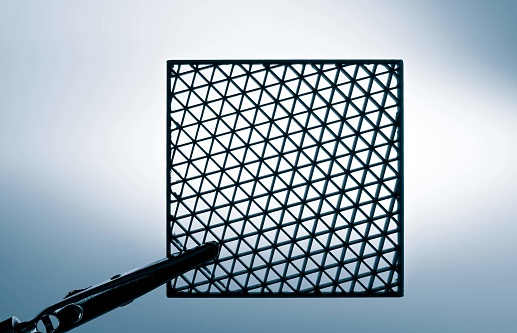Automated drawing machine for making paper-based metamaterials

Metamaterials are described as artificial materials. They acquire electromagnetic properties from patterned microstructures. These materials can be used for manipulating electromagnetic waves.

Keywords: Metamaterials, ballpoint pen, stepper motors, drawing patterns, metasurface, a polarization converter, an absorber, a conformal coding metasurface
Research team leader Junming Zhao from Nanjing University in China said, "Metamaterials, especially those used as absorbers, generally need to be thin, lightweight, wide and strong, but it isn't easy to create thin and lightweight devices using traditional substrates". "Using paper as the substrate can help meet these requirements while also lending itself to metasurfaces that conform to a surface or that are mechanically reconfigurable".
For carrying out the study, researchers used a ballpoint pen with conductive ink for drawing conductors and they used mechanical pencils to draw resistors and resistive films. For making this process more automated, the researchers made use of computer-controlled drawing machines.
Lead researcher Zhao said, "Although paper-based metamaterials have been made previously using inkjet printing technology, our drawing technique is lower cost, simpler and more flexible". "Our method could be useful for making reconfigurable antennas and metalenses as well as metamaterial devices that absorb incident electromagnetic energy from cell phones or other sources."
The new drawing machine uses a pen with ink that contains conductive material or normal mechanical pencils. The machine has three stepper motors. Two stepper motors are responsible for controlling the movement of the pen in the horizontal plane and the third one is responsible for lifting or dropping the pen in the vertical plane. The movement and speed of the drawing machine are controlled by the computer.
Lead researcher Zhao said, "Some of the paper we tried was not very compatible with the pencils or conductive ink pens, resulting in poor conductivity of the drawn patterns". "After some testing, we found the best performance came from using paper that is .22 mm thick, which is easy to obtain and very compatible with the pencils and conductive ink."
The researchers used a conductive ink pen to draw various patterns on paper. They found the conductivity of patterns to be 3×106 Siemens per meter. The researchers tested this pencil with various parameters such as discrete drawing pressure and various amounts of graphite. The purpose of the testing was to characterize the electrical resistance affected due to these factors. Thus it gave a way for researchers to validate the conditions required for drawing patterns with a specific resistance.

The researchers designed three different paper-based metamaterials:
- A polarization converter
- An absorber
- A conformal coding metasurface
The researchers proved that the polarization converter could rotate linear polarization by 90°. The conversion efficiency ranged from 3.2 to 6.6 GHz.
The absorber had a mass of just 58.3 grams. It was capable of achieving 90% absorptivity ranging from 2.1 GHz to 10.5 GHz.
The conformal coding metasurface can be used for radar cross-section reduction. When the metasurface was bent on a curved surface, it achieved a 10dB radar cross-section reduction. The frequency band was from 8.94 to 11.59 GHz.
"We hope that in the future, we can use the drawing technology to design and fabricate meta-devices that could be carried or applied to the skin to achieve electromagnetic shielding and other functions," said Zhao. "We also plan to design mechanically reconfigurable metamaterials that take advantage of the fact that paper can be bent and folded."
Story Source:
Materials provided by Optica. The original text of this story is licensed under a Creative Commons License. Note: Content may be edited for style and length.
Journal Reference:
- Kaiyue Zhu, Shuyang Hao, Ke Chen, Tian Jiang, Junming Zhao, Yijun Feng. Directly drawing metamaterials on paper based on an automatic drawing machine. Optical Materials Express, 2022; 12 (11): 4299 DOI: 10.1364/OME.472866
0 Comments